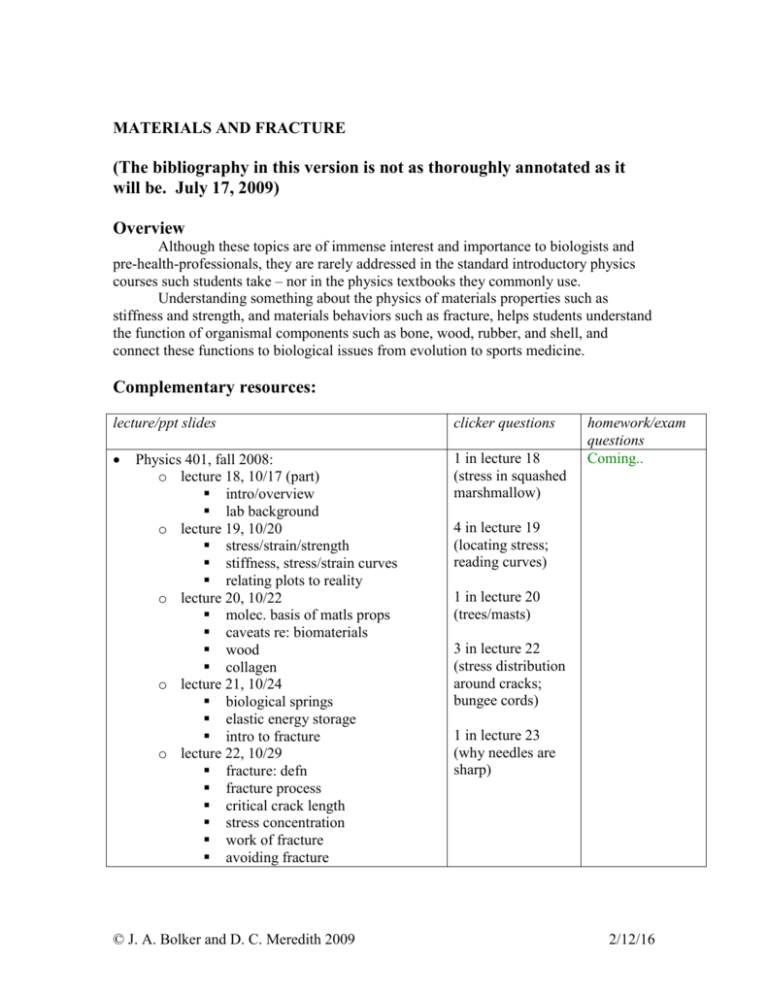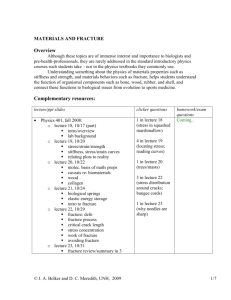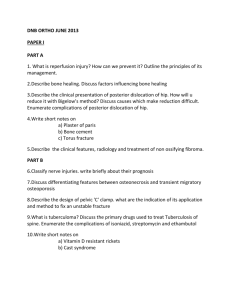Word format - Instructor Resources
advertisement

MATERIALS AND FRACTURE (The bibliography in this version is not as thoroughly annotated as it will be. July 17, 2009) Overview Although these topics are of immense interest and importance to biologists and pre-health-professionals, they are rarely addressed in the standard introductory physics courses such students take – nor in the physics textbooks they commonly use. Understanding something about the physics of materials properties such as stiffness and strength, and materials behaviors such as fracture, helps students understand the function of organismal components such as bone, wood, rubber, and shell, and connect these functions to biological issues from evolution to sports medicine. Complementary resources: lecture/ppt slides clicker questions 1 in lecture 18 (stress in squashed marshmallow) Physics 401, fall 2008: o lecture 18, 10/17 (part) intro/overview lab background o lecture 19, 10/20 stress/strain/strength stiffness, stress/strain curves relating plots to reality o lecture 20, 10/22 molec. basis of matls props caveats re: biomaterials wood collagen o lecture 21, 10/24 biological springs elastic energy storage intro to fracture o lecture 22, 10/29 fracture: defn fracture process critical crack length stress concentration work of fracture avoiding fracture © J. A. Bolker and D. C. Meredith 2009 homework/exam questions Coming.. 4 in lecture 19 (locating stress; reading curves) 1 in lecture 20 (trees/masts) 3 in lecture 22 (stress distribution around cracks; bungee cords) 1 in lecture 23 (why needles are sharp) 2/12/16 materials and fracture o lecture 23, 10/31 fracture review/summary in 3 forms: verbal, graphical, equations bone skin Physics concepts Materials properties o strength, stiffness, stress, strain (and the distinctions among them) o deformation, reversible and otherwise o elastic energy storage in materials o Hookean and non-Hookean materials o toughness and work of fracture o biological fluids (shear-dependent viscosity, etc.) o properties may vary with physical factors such as temperature, hydration Fracture o different modes and stages of material failure o connection between energy, work, and fracture Griffith critical crack length mechanisms of crack propagation (and how to slow/stop cracks) o safety factors; damage/injury short of failure o strategies to prevent fracture and/or slow crack propagation molecular level layers with different properties (plywood, bone) ways to absorb energy within materials and structures Linking structure and function from molecules to elephants o many beautiful and well-documented biological examples bone, shell, skin, tendon, fibers, mucus, etc. o composite materials comprising components with complementary properties Comparing and contrasting biology and physics o evolved solutions to physical challenges o physical constraints on biological structure and function o differences between biological materials, and the materials more often considered by physicists and engineers types of materials (e.g. metals rare in biology) composite materials (prevalent in biology) rate-dependent physical properties (complicated, but common in biology) “non-ideal” in other ways: often not Hookean, Newtonian, …. opportunities for biomimetic design of engineered materials how well can standard, relatively tractable equations describe messy biological materials? when are first approximations appropriate and useful, vs. when does simplification eliminate too much reality? © J. A. Bolker and D. C. Meredith 2009 2/12/16 materials and fracture Materials properties and fracture are described and understood by engineers in extremely technical, mathematics-intensive ways. However, as Gordon delightfully demonstrates in Structures (1978), the underlying concepts and basic mechanisms are readily accessible via verbal and graphical descriptions (as well as compelling anecdotes, and personal experience). It is possible to design quantitative problems in this area that are appropriate for an introductory-level course, but the topic lends itself better to development/reinforcement of students’ abilities to construct and interpret plots. In particular, stress-strain curves offer an excellent demonstration of the value of dimensionless numbers/ratios (such as strain), which describe fundamental, intrinsic properties of a material irrespective of how much of it you’re dealing with, or the absolute size of the deformation (additional resource: materials lab). There is also ample scope for dimensional analysis, which can be very useful in sorting out all the terms that begin with “s” (stress, strain, stiffness) and understanding how they are interrelated. If dimensional analysis were introduced earlier in the course, for example in the context of kinematics, this would be a good place to reinforce it – particularly as the units and kinds of measurements that describe materials properties are likely to be novel to students: they all know a term like “stress,” but have probably not previously defined it specifically as force/area. Biological background These topics offer a superb opportunity to connect structure and function across many levels of biological organization, from intermolecular bonds, to macromolecular structure, to the constitution of tissues and the shape of individual body parts. For those interested in evolution (whether instructors, or students), the realization that materials as well as structures are adaptively tuned by natural selection opens up a new perspective – and a set of good interdisciplinary research questions. References Biomaterials and biomechanics information (and work) occurs in several different contexts, often with surprisingly little cross-communication: • Engineering, both addressing the properties natural materials such as wood, and drawing on the evolved characteristics of biomaterials to design novel synthetic ones • Medical/human: orthopedics, kinesiology, athletics, rehabilitation • Functional morphology of non-human organisms • Biophysics: most often refers to work on molecular or smaller scales; not within the scope of our introductory physics course. One practical consequence is that resources such as books and journals may be distributed across multiple sites, if the institution has specialized library branches (e.g. for biology, physics, health/medical sciences, and engineering). A second is that there may © J. A. Bolker and D. C. Meredith 2009 2/12/16 materials and fracture be great resources, from texts to colleagues with relevant research programs and expertise, in what first appear to be unlikely places: for example, track coaches often know a lot about the function and properties of human skeletal and muscle tissues; engineers may have equipment useful for collecting data from biological samples. Primary: Gordon, J.E. 1978. Structures: or Why Things Don’t Fall Down. Plenum Press Chatty and accessible, as well as admirably clear about core issues of materials properties and fracture processes. Lots of anecdotes and examples; a fun book to read straight through, but for course use, it’s best read or assigned in topical sections. This is easy to do because the index is thorough. (I’m pretty sure there is not a formal bibliography, however: this book is good for concepts, but not as an entrée to the primary literature.) Not explicitly focused on biology, though it contains some human examples along with a lot of engineering (and a fair dose of history, ancient and modern); the engineering applications include mechanics of wood, a classic biomaterial. Wainwright, S.A., Biggs, W.D., Currey, J.D. and Gosline, J.M. 1976. Mechanical Design in Organisms. Princeton University Press. Tough going, but excellent index and superb bibliography. A compendium and reference work, best dipped into by topic, rather than a textbook. The standard reference for biologists interested in these issues. Vogel, S. 2003. Comparative Biomechanics: Life’s Physical World. Princeton University Press, Princeton NJ. Level: Designed for undergraduates, though the organization can be hard to follow and the explanations are often somewhat discursive. Presumes some biological background, but avoids technical terminology. From the preface (p. ix): “…the book is intended to be used as a textbook for undergraduates in biology at any level beyond an introductory course – or undergraduates in any other area of science or engineering willing to refer from time to time to a basic textbook of biology, or graduate students or other scientists and engineers who need an entry point that gets them into the content and literature of biomechanics.” Format: The volume is designed as a textbook, albeit with somewhat quirky organization (it will look weirder to physicists than to biologists, as the latter are likely to have few a priori expectations about how the material/topics ought to be organized). Per the title, the focus is primarily biomechanics, rather than an attempt to cover all topics at the interface between physics and biology. Broad coverage (vertebrates, invertebrates, plants) extends well beyond the human-centric treatment provided by texts designed for kinesiology, orthopedics, sports medicine, physical therapy, etc. This is to my knowledge the only purpose-designed undergraduate-level comparative biomechanics text available. Symbol conventions do not necessarily align with standard physics or engineering usage (though those don’t necessarily align with each other, either). If using excerpts © J. A. Bolker and D. C. Meredith 2009 2/12/16 materials and fracture from this book alongside a standard physics text, it’s important to flag these discrepancies for students. Notes: The introductory chapters on “Setting the stage,” “Size and scale,” and “More tools” offer refreshingly concise introductions to basic (physical and mathematical) concepts, tools, and terminology, including a lucid presentation of dimensional analysis. The preface and the final chapter (“Loose ends and perspectives”) offer a helpful and interesting overview of what is and is not covered in the book, and why. These sections may not be directly useful to students, but are a useful guide for instructors, especially those unfamiliar with the field. The index and bibliography are excellent, and the bibliography has the added virtue of indicating where in the text each source is cited. For materials and fracture: These are the central concerns of Part Three of the book, particularly chapters 15-17. The discussion of materials is closely integrated with the coverage of structures (beams, hydrostats, musculoskeletal arrangements, etc.). Gordon, J.E. 1976. The New Science of Strong Materials: or Why You Don’t Fall Through the Floor. 2nd edition. Princeton University Press, Princeton NJ. “This book is about how we have come to understand the strength of materials, about how the strength of metals and wood and ceramics and glass and bone are interrelated and about how and why these materials behave in various kinds of stuctures such as machinery and tools and ships and aeroplanes and buildings and bridges.” chapter 1, pp. 15-16) More focused on materials and on engineering than Structures (also by Gordon), and less on biology. Nevertheless, a wonderful book that covers topics one might want to include in an introductory physics course but that are rarely included in textbooks designed for such classes. For materials and fracture: Chapter 5 is a more cohesive and somewhat more detailed explanation of fracture mechanics and toughness than is presented in Structures; chapter 6, “Timber and celluluse: or wooden ships and iron men” focuses on the properties and structure of plant biomaterials, especially in a nautical (and historical) context. Rayner, JMV and RJ Wootton, eds. Biomechanics in evolution. Soc for Exper Biology seminar series 36, 1991. BioSci QH513.B56 1991 A wide range of superb paleontology examples, as well as both demonstration and discussion of the value of biomechanics/physical approaches for making inferences about the function of extinct organisms. Many volumes on biomaterials can be found on the shelves of engineering and medical (though not necessarily biology or physics) libraries. © J. A. Bolker and D. C. Meredith 2009 2/12/16 materials and fracture Vincent, J. 1990. Structural biomaterials. (revised edition) Princeton University Press. Good coverage of standard materials such as bone, collagen, wood, and shell. Hastings, G. and Ducheyne, P. eds. 1984. Natural and living biomaterials. CRC Series in Structure-Property Relationships of Biomaterials. CRC Press. Human/medical focus on “…the treatment of disease and injury by the use of new materials and by further understanding of living materials.” Also addresses study methods, e.g in vitro vs. in vivo. The field has come a long way since 1984, but there is good basic information in here, especially about bone (including micrographs of fractures). Some morphology and anatomy textbooks have brief sections devoted to the physical properties of important structural materials such as bone – and biology students are very likely to have one or more such books already in their possession (though they may never have noticed, or been assigned, the sections on physics and materials properties). For example: Liem, K.F., Bemis, W.F., Walker, W.F. and Grande, L. 2001. Functional Anatomy of the Vertebrates: an Evolutionary Perspective. Third edition. Harcourt College Publishers, New York. Pages 181-183 give a brief overview of stress and strain, in the context of a chapter (5) on “Form and function” that also includes overviews of several other physics topics (kinematics, force, hydrostats) immediately relevant to vertebrate biology. Database searches, as well as the bibliographies of some of the works listed above, yield citations of papers (and books) focused on specific biomaterials – from engineering, medical, and/or functional biological perspectives. These range from extremely technical, to articles from magazines such as American Scientist and Physics Today that are very accessible to instructors and students who may be learning about the physics of biomaterials for the first time. Ritchie, R.O., Buehler, M.J., and Hansma, P. 2009. Plasticity and toughness in bone. Physics Today June 2009, pp. 41-47. VERY useful, with beautiful graphics (diagrams, plots, and micrographs). Ballarini, R. and Heuer, A.H. 2007. Secrets in the shell. American Scientist 95(5):422-429. This would be a nice one to assign to students, if copyright © J. A. Bolker and D. C. Meredith 2009 2/12/16 materials and fracture permission could be obtained. Like all American Scientist papers, it’s by an expert in the field, but accessible – and well-illustrated. Vogel, S. Cats’ paws and catapults. Norton, 1998. BioSci QH513.V64 1998 (nice plot of strength-strain-stiffness-toughness on p. 84) A few things about biomimetics – which is a very nice link between biology, physics, and engineering, with lots of fascinating medical examples (artificial joints, bone, skin, tooth materials, ….). Munch, E., Launey, M.E., Alsem, D.H., Saiz, E., Tomsia, A.P., and Ritchie, R.O. 2008. Tough, bio-inspired hybrid materials. Science 322:1516-1520. doi: 10.1126/science.1164865 © J. A. Bolker and D. C. Meredith 2009 2/12/16








